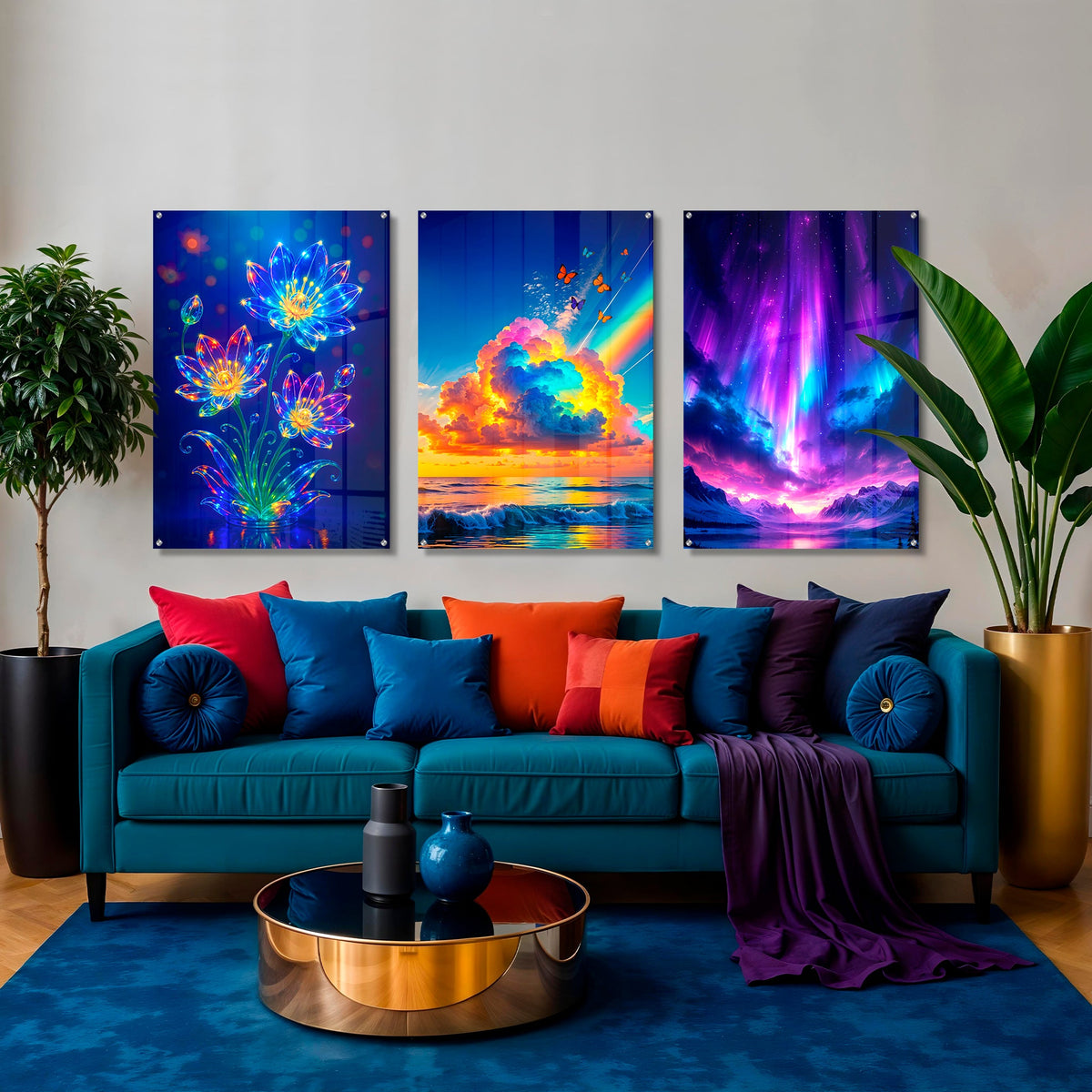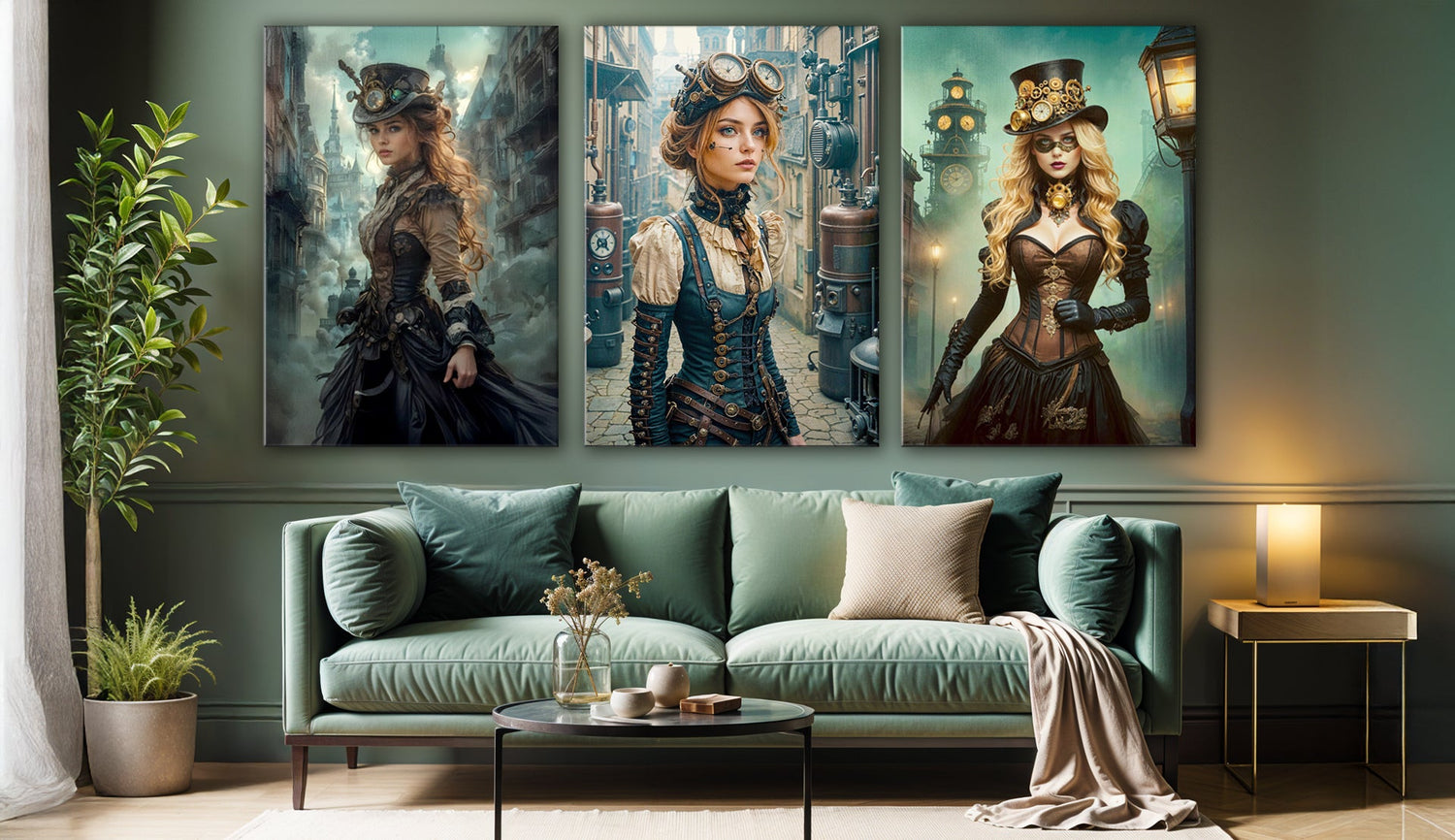
When Color Becomes Atmosphere: Living With a Trio of Acrylic Prints
Some walls sit quietly, content to disappear. Others beg for something more. You might notice it late at night, when the furniture is neatly arranged, the lighting is pleasant, yet the room still feels unfinished. It’s in moments like this that artwork often changes the conversation. Not every piece of art, of course—some prints fade into the background—but certain works seem to breathe into a room. The trio of acrylic wall prints known as Glass Flowers, Northern Lights, and Rainbow Cloudscape belongs, perhaps, to that rarer category.
A Conversation in Three Voices
It may seem at first glance that these three prints have little in common. One is a luminous bouquet that looks as though it’s been shaped from stained glass, another captures the sweep of the aurora spilling across a northern sky, and the third shows a cloud torn open by rainbow light above the sea. If judged individually, they could each carry a room. Yet together, they create a surprising kind of dialogue: intimacy, vastness, and hope set side by side.
There’s always the risk with sets that they feel overly matched, like hotel art designed to blend in. This collection sidesteps that. Instead of repeating the same mood three times, each print extends the range of the others. The flowers root the set in detail, the aurora stretches it outward, and the cloudscape lifts it toward optimism.
How Acrylic Alters What You See
The material matters. Acrylic isn’t everyone’s preference; some find its gloss too sharp, especially if they’re drawn to matte finishes that absorb light instead of reflecting it. But for artwork built on radiance, the surface seems to intensify the experience. The glossy panel catches light during the day, so the flowers sparkle and the aurora deepens, and at night under lamplight the rainbow cloud glows like embers at sunset.
In practical terms, acrylic resists moisture and fading, which suggests it could work in kitchens or bathrooms as well as living spaces. Yet what lingers most is not its durability but the way it appears to make colors hover slightly above the surface, as if the image carries depth beyond the wall.
Shaping the Mood of Different Rooms
Every room carries its own rhythm, and this set seems capable of adjusting to those variations. In a living room, a large-scale display over the sofa might ground the space, drawing people into conversation. In a bedroom, the same prints might take on a quieter role above the bed, their glow softening into something dreamlike. Even in an office, where artwork often feels decorative at best, the aurora’s sense of movement could introduce a reminder of possibility.
Bathrooms, usually overlooked in design, might actually benefit from a smaller version of Glass Flowers or Rainbow Cloudscape. The glassy surface of the print fits naturally with tiles and mirrors, and the sudden burst of color in such a private space can feel unexpectedly cheerful.

Beyond the Straight Line
The conventional approach is to hang three prints side by side. There’s nothing wrong with this—symmetry has its own charm—but it can also feel rigid. These particular works invite play. Imagine stacking them vertically along a tall wall, creating the sense of a glowing column. Or placing them in a gentle diagonal across a wide surface, the flowers low, the aurora rising, and the cloud floating at the top, as though following a natural progression.
Another option is to separate them, placing one in a hallway, another in a dining space, and the third in a bedroom. Instead of one concentrated burst of color, the home gains a thread of continuity, each room linked by a tone the others echo.
A Story of a Space Transformed
Picture a dining room: polished wood table, clean lines, tasteful but restrained. The room feels correct but not especially memorable. Then, one afternoon, the Northern Lights is mounted on the wall opposite the table. Suddenly meals carry a backdrop of violet and turquoise sky. Guests pause, forks in hand, and conversations tilt toward travel or memory. A single image changes the atmosphere of the room—not by adding furniture or light, but by introducing a sense of wonder that lingers even when the meal ends.
Considering Strengths and Limitations
No medium or collection is without drawbacks. Acrylic’s high shine can reflect lamps in awkward ways, and such bold imagery may clash with interiors designed around restraint. Yet those very qualities, in the right context, become strengths. The gloss can make daylight feel alive, and the intensity of color may be precisely what an otherwise neutral room craves.
The decision, then, is less about whether these prints are “good” or “bad” and more about whether they resonate with how you want to inhabit a space.
Closing Thought
Living with art is rarely about utility. A chair is for sitting, and a lamp is for light. A wall print, though, is for atmosphere, memory, and imagination. This trio—flowers of glass, skies alive with aurora, and a rainbow cloud above the sea—offers not certainty but possibility. They may shift how a room feels, or they may shift how you feel within the room.
For anyone sensing that a wall in their home is waiting for something more, the Colorful Acrylic Wall Art Collection might not just decorate it but transform it into a moment of light, color, and breath.







